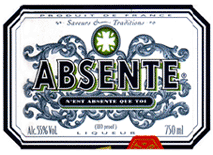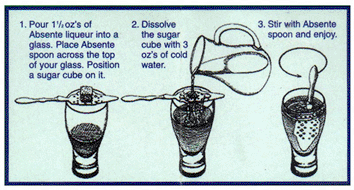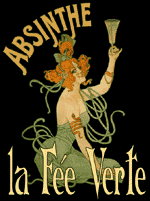![]()
Recent Articles
Archive of National Post Articles
![]()

Victoria
Day and Absinthe ~ Fireworks for the mind ©
©
Michael Vaughan 2001
National Post Weekly Wine & Spirits
Columnist
Saturday, May 19, 2001
With
Victoria Day at hand complete with all the spectacular pyrotechnics, I
pondered on the spirits which ignite. At one time, not so long ago, the
best ways of lighting a fire in your companion’s eyes would be to sip a
flaming Sambuca after a romantic meal. I
remember crunching into the bitter espresso coffee bean, which innocently
floated on its fiery surface. It made the hot, sweet, viscous,
licorice-flavoured liqueur beneath even more exciting. Not only was it
delicious, but also served as the perfect breath cleanser, a hopeful
harbinger of the delights to follow.
 Unfortunately,
my bartending friends tell me that flaming Sambuca is about as fashionable
as old polyester suits. But perhaps there’s still hope. Last
Saturday’s Vintages release featured a very new take on a very old
spirit – Absinthe. It’s called Absente and comes in a fancy gift
box complete with an Absinthe spoon all for $47.95.
This isn’t too bad when you consider that the same package retails for
over $40 in the US.
Unfortunately,
my bartending friends tell me that flaming Sambuca is about as fashionable
as old polyester suits. But perhaps there’s still hope. Last
Saturday’s Vintages release featured a very new take on a very old
spirit – Absinthe. It’s called Absente and comes in a fancy gift
box complete with an Absinthe spoon all for $47.95.
This isn’t too bad when you consider that the same package retails for
over $40 in the US.
Absente has a
clear day-glow light green colour eerily similar to the original stuff
marketed by those lovely nineteenth century posters. Its sweet, honeyed,
gently herbal, licorice-driven flavours are reminiscent of Pernod and
Chartreuse, while the peppery finish is related to its 55% alcohol level.
The slotted flat Absinthe spoon is key to the serving ritual. It would be
laid flat across the top of a glass containing 1-1/2 ounces. Then 3 ounces
of cold water would be poured over two sugar cubes. This supposedly would
dissolve the sugar and sweeten the now-cloudy drink.

Unfortunately
North American sugar cubes are harder being much more tightly packed than
the traditional French variety. This meant that I had to dump the remnants
of the cube into the glass and use the spoon for stirring. As for the
resulting taste, I actually preferred the stuff neat! Keep in mind that
these Absinthe substitutes are much, much, sweeter than their original
versions making the ritual somewhat redundant.
Absente is
produced in Provence, France by Vin & Spirit (the Swedish producers of
Absolute) for American distributor and marketing guru Michel Roux. And
while one might be forgiven for mistaking Absente for Absinthe, the former
is definitely a sheep in wolf’s clothing because with the exception of
alcohol, all the key ingredients, which gave the original its bad rap,
have been carefully removed.
 Dr.
Pierre Ordinaire reputedly invented the original in 1792. This cure-all
was nicknamed “La Fée Verte” (The Green Fairy) for its uplifting
powers. The recipe was subsequently to Major Dubied whose daughter married
Henri-Louis Pernod who began producing the stuff in 1805. Originally the
drink of the rich, by1870’s the French consumption amounted to 700,000
liters annually, which went through the roof to 36 million liters by 1910!
Dr.
Pierre Ordinaire reputedly invented the original in 1792. This cure-all
was nicknamed “La Fée Verte” (The Green Fairy) for its uplifting
powers. The recipe was subsequently to Major Dubied whose daughter married
Henri-Louis Pernod who began producing the stuff in 1805. Originally the
drink of the rich, by1870’s the French consumption amounted to 700,000
liters annually, which went through the roof to 36 million liters by 1910!
The essence of
Absinthe is the extract from wormwood, which gives it an emerald green
colour and its extremely bitter taste. Wormwood is a widely found shrubby
plant native to the Mediterranean, which grows up to four feet high and
has small yellow flower heads. It was called
absinthium by the Romans for
the Latin word absinthial meaning bitter. Indeed, it is so bitter that the
Greeks apparently mixed it with wine and given to winning Olympic athletes
to remind them of the bitterness of defeat.
Rich in
essential oils, the key active ingredient in wormwood is thujone,
a terpene that can cause convulsions mimicking epilepsy and permanent
brain damage. While wormwood’s medicinal use can be traced back 3,500
years, it was the king of Absinthe, Henri-Louis Pernod who used aniseed,
hyssop, fennel and lemon balm along with star anise, dittany, juniper,
nutmeg, veronica and angelica to popularize the beverage. These
ingredients were macerated with wormwood and then distilled up to 75%
alcohol. Some producers used calamus, wood alcohol and other
toxic/psychoactive ingredients.
Of course,
absinthe wasn’t the only dangerous spirit. Vermouth, Chartreuse,
Benedictine and a host of other herbal beverages all used to contain
thujone. In fact, Vermouth is made from wormwood
flower heads and got its name from "wermuth" (German for
"wormwood"). Fortunately you don’t have to be concerned about
because the international threshold is 10 parts per billion – a fraction
of past levels.
When the US
banned it in 1912, it had already taken hold in New Orleans. France held
out until 1915, which coincided with the closing of Pernod’s plant and
didn’t reopen until the mid 1940’s with a new, improved, safe version.
Dozens of anise-tasting spirits exist, from Ouzo and Pastis to Arak.
Ironically, you can still get versions of the real thing in Czechoslovakia
and Spain where apparently no laws were passed banning this product.
Indeed, today there are Absinthe cult bars in London where these
mind-altering spirits can be readily found.
Of course
there are dozens of “Absinthe” inspired drinks from around the world.
At the Old Absinthe House in New Orleans, for instance, it was mixologist
Cayetano Ferrer who in 1874 not only created the Absinthe House Frappe but
also used it to liberate the flavours of their Oysters Rockefeller.
To make the former, fill a tall glass with crushed ice,
add 1-1/4 ounce of Herbsaint (or Absente), 1/4 ounce of Anisette
(or Pernod) and top with soda
water to taste (2-4 ounces).
In fact, it was here at the bar where I discovered from a fellow imbiber that it was their popular locally-distilled Herbsaint liqueur that supposedly inspired Jerry Lee Lewis to write “Great Balls of Fire” (and I though it was his teenage lover). Of course, when it comes to fireworks, the folks in the Ukraine had it absolutely right. They named a town after the region’s most prolific bush - wormwood or “chernobyl!”
For additional information on the
Absinthe posters, etc. see
http://www.sepulchritude.com/chapelperilous/absinthe/index.html
Copyright Food & Beverage Testing Institute of Canada
2004
Prior written permission is required for any form of reproduction
(electronic or other wise) and or quotation.
Contact Michael Vaughan at
mbv@total.net